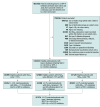Comparing Effectiveness and Safety of SGLT2 Inhibitors vs DPP-4 Inhibitors in Patients With Type 2 Diabetes and Varying Baseline HbA1c Levels
- PMID: 36745425
- PMCID: PMC9989905
- DOI: 10.1001/jamainternmed.2022.6664
Comparing Effectiveness and Safety of SGLT2 Inhibitors vs DPP-4 Inhibitors in Patients With Type 2 Diabetes and Varying Baseline HbA1c Levels
Erratum in
-
Error in the Text.JAMA Intern Med. 2025 Mar 1;185(3):352. doi: 10.1001/jamainternmed.2024.7944. JAMA Intern Med. 2025. PMID: 39804610 Free PMC article. No abstract available.
Abstract
Importance: Sodium-glucose cotransporter 2 inhibitor (SGLT2i) therapy has been associated with cardiovascular benefits and a few adverse events; however, whether the comparative effectiveness and safety profiles vary with differences in baseline hemoglobin A1c (HbA1c) levels is unknown.
Objective: To compare cardiovascular effectiveness and safety of treatment with SGLT2i vs dipeptidyl peptidase 4 inhibitor (DPP-4i) in adults with type 2 diabetes (T2D) (1) overall and (2) at varying baseline HbA1c levels.
Design, setting, and participants: A new-user comparative effectiveness and safety research study was conducted among 144 614 commercially insured adults, initiating treatment with SGLT2i or DPP-4i and with a recorded T2D diagnosis at baseline and at least 1 HbA1c laboratory result recorded within 3 months before treatment initiation.
Interventions: The intervention consisted of the initiation of treatment with SGLT2i or DPP-4i.
Main outcomes and measures: Primary outcomes were a composite of myocardial infarction, stroke, or all-cause death (modified major adverse cardiovascular events [MACE]) and hospitalization for heart failure (HHF). Safety outcomes were hypovolemia, fractures, falls, genital infections, diabetic ketoacidosis (DKA), acute kidney injury (AKI), and lower-limb amputation. Incidence rate (IR) per 1000 person-years, hazard ratios (HR) and rate differences (RD) with their 95% CIs were estimated controlling for 128 covariates.
Results: A total of 144 614 eligible adults (mean [SD] age, 62 [12.4] years; 54% male participants) with T2D initiating treatment with a SGLT2i (n = 60 523) or a DPP-4i (n = 84 091) were identified; 44 099 had an HbA1c baseline value of less than 7.5%, 52 986 between 7.5% and 9%, and 47 529 greater than 9%. Overall, 87 274 eligible patients were 1:1 propensity score-matched: 24 052 with HbA1c less than 7.5%; 32 290 with HbA1c between 7.5% and 9%; and 30 932 with HbA1c greater than 9% (to convert percentage of total hemoglobin to proportion of total hemoglobin, multiply by 0.01). The initiation of SGLT2i vs DPP-4i was associated with a reduction in the risk of modified MACE (IR per 1000 person-years 17.13 vs 20.18, respectively; HR, 0.85; 95% CI, 0.75-0.95; RD, -3.02; 95% CI, -5.23 to -0.80) and HHF (IR per 1000 person-years 3.68 vs 8.08, respectively; HR, 0.46; 95% CI, 0.35 to 0.57; RD -4.37; 95% CI, -5.62 to -3.12) over a mean follow-up of 8 months, with no evidence of treatment effect heterogeneity across the HbA1c levels. Treatment with SGLT2i showed an increased risk of genital infections and DKA and a reduced AKI risk compared with DPP-4i. Findings were consistent by HbA1c levels, except for a more pronounced risk of genital infections associated with SGLT2i for HbA1c levels of 7.5% to 9% (IR per 1000 person-years 68.5 vs 22.8, respectively; HR, 3.10; 95% CI, 2.68-3.58; RD, 46.22; 95% CI, 40.54-51.90).
Conclusions and relevance: In this comparative effectiveness and safety research study among adults with T2D, SGLT2i vs DPP-4i treatment initiators had a reduced risk of modified MACE and HHF, an increased risk of genital infections and DKA, and a lower risk of AKI, regardless of baseline HbA1c.
Conflict of interest statement
Figures




References
-
- Centers for Disease Control and Prevention . National Diabetes Statistics Report. 2022. Accessed April 28, 2022. https://www.cdc.gov/diabetes/data/statistics-report/index.html
Publication types
MeSH terms
Substances
Grants and funding
LinkOut - more resources
Full Text Sources
Medical
Miscellaneous

